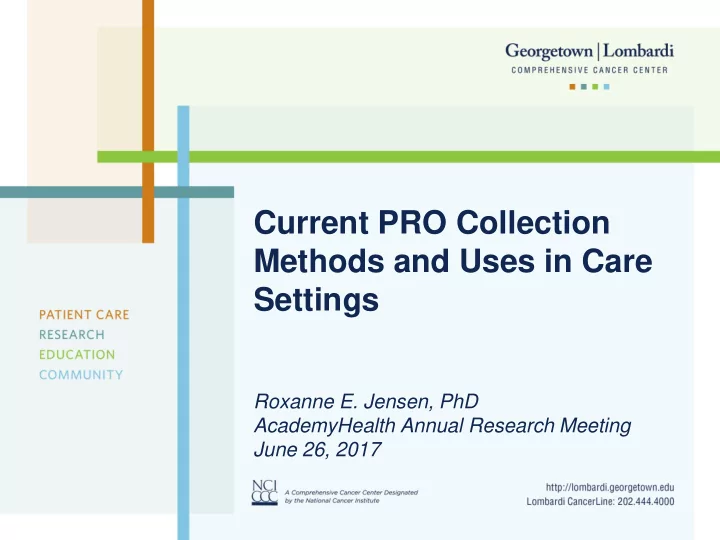

Current PRO Collection Methods and Uses in Care Settings Roxanne E. Jensen, PhD AcademyHealth Annual Research Meeting June 26, 2017
Rapid Adoption in Clinical Care Settings • New Methods – Item Response Theory – Computer Adaptive Testing • New Tools – Patient-Reported Outcomes Information System (PROMIS) • New Technology – April 3, 2010
New Technology: The iPad Era (2010) Before After • Often Paper • Electronic • Closed Systems • Web-Based • High Hardware Costs, • Lower Costs & Patient in-house development Awareness • Patient-Level Use Only • Clinic & Population-Level Monitoring
PRO Use in Clinical Care • Individual Care – Patient fills out a PRO – Scores are reviewed by Clinician – Examples: Depression Screening, Symptom Monitoring during Chemotherapy, Decision Support • Clinic-Level Evaluation – Quality of care evaluation – Quality Improvement – Example: % Screened for Depression
Data Collection Methods 1. Paper Collection 2. Independent Electronic System 3. Internal Collection within EHR system
PRO Collection Method #1 • Paper Collection – Patient fills out a paper PRO measure – All scoring is done manually by staff • Care Integration – Discussed in care visit – Uploaded to EHR • Scanned Paper Form • Manual Data Entry • Manual PRO Documentation in the Clinic Note
Strengths/Weaknesses • Best suited for simple screening tasks – Quick Scoring Screening Measures for Immediate documentation or use. – Quality Evaluations based on screening tasks being performed. • May be preferred by some patients • Score review and reporting options are limited
Paper Assessment MRN:_______
Paper Assessment MRN:_______
Paper Assessment MRN:_______
PRO Collection Method: #2 • Independent Electronic System – Stand-alone system – Electronic PRO collection – 3 rd party vendor – Developed internally • AKA… – ePRO – Side Car – Wrap Around
ePRO Care Integration • Highly Customizable • Visual Formats and Measures • Collection Methods (Apps, Web) • Staff Management Support and Tools • Communication with EHR systems • Data pushed to the EHR in real-time • Data linked to discrete EHR data fields • EHR data pulled to inform assessment
Strengths/ Weakness • Often built with symptom monitoring and decision support goals. • Systems require more steps to log-on, administer and review content. • Data Integration with an EHR system is often limited – Difficulty identifying eligible patients – Difficulty pushing information into EHR system
External System: Care Prompter
Lombardi Electronic Distress Screening Program • All new patients screened in clinic after check-in • High scores are: – Followed up on by a social worker – Available for review in the EHR.
Integration into EHR
PRO Collection Method #3 • Internal Collection within EHR system – PRO assessment is collected as an integral part of the EHR – Often assessed through a patient portal – Structured data (responses and total score) are accessible
Strengths/ Weakness • Allows for real-time integration of content for clinical decision-making • Easier aggregation of PROs alongside other standard performance measures • PRO content and display options can be limited. – Assessment – Score Report and Interpretation
Lurie Screening Initiative
In-Clinic Assessment Using iPads
Lurie Screening Initiative • PROMIS CAT • Practical Needs & Other Concerns: – Pain – Social work needs – Fatigue – Informational – Physical Function needs – Depression – Nutritional status – Anxiety Total Length: ~ 40 items (8-10 mins) Frequency: Once every 30 days paired with visit Pearman et al, 2016; Wagner et al, Cancer, 121(6): 927-934, 2015
Integration Into Clinical Care • Assessment results populated in Epic – Other Orders tab – .dot phrases for charting • Messaging for severe symptoms – Based on PROMIS T-Score Severe Cut Points. – MD & RN messages when Anxiety > 65 – MD & RN messages when Pain > 70
Discussion & Conclusion • Strengths and Weaknesses of each PRO system depends on: – Purpose – Availability – Cost & Expertise Available – Workflow Considerations
Further Reading: Snyder C, Wu A (Eds). Users’ Guide to Integrating Patient-Reported Outcomes in Electronic Health Records. Patient-Centered Outcomes Research Institute, 2017. Available at: https://www.pcori.org/document/users-guide-integrating- patient-reported-outcomes-electronic-health-records
Recommend
More recommend